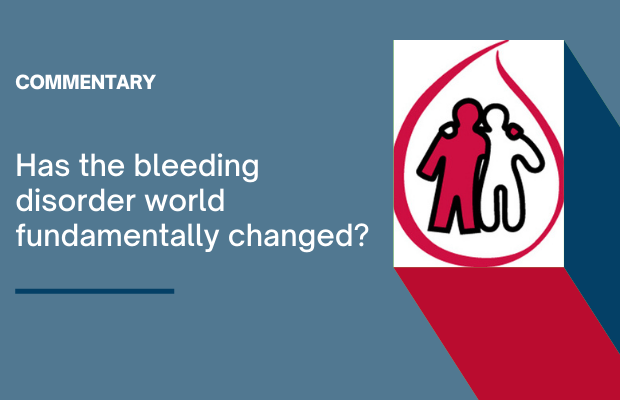Has the bleeding disorder world fundamentally changed?

by David Page, CHS National Director of Health Policy
Given recent advances in therapies for inherited bleeding disorders, especially hemophilia A and B, I have heard people, both inside and outside our close circle, say that the bleeding disorder world has fundamentally changed and the work of the CHS will be much different in the future. Intriguing thought.
To be sure, in the last few months, we have seen a couple of significant advances. Emicizumab (Hemlibra) is a major treatment breakthrough and was made available to people with inhibitors to factor VIII in 2019 and to those with severe hemophilia A without inhibitors in most of Canada in October 2021, and the transition process is proceeding apace. Hopefully, there will be similar good news from Quebec in coming weeks. Emicizumab is life-changing for those with inhibitors. The most recent Canadian Blood Services tender, whose resulting contracts take effect on April 1, has resulted in the widest range of factor VIII and IX concentrates ever seen, including extended half-life products, all without special constraints on access. Again, we have to await the results of the current tender in Quebec but can be hopeful that the access situation will improve there, too.
And the pipeline of products in clinical trials is full. Much longer half-life FVIII concentrates, more potent monoclonal antibodies that act like emicizumab; coagulation system re-balancing strategies like fitusiran, anti-TFPIs and anti-protein C; and gene therapy show promise, not only for hemophilia A and B but in some cases across the spectrum of bleeding disorders, albeit with many critical unanswered questions concerning safety and efficacy.
Do these advances in care and treatment mean that the CHS needs to fundamentally shift its mission and work?
First of all, these treatment breakthroughs do not and will not turn back the clock. The longstanding burdens of disease and treatment blood-borne pathogens, the psychosocial and socioeconomic consequences of chronic disease, and the pain and disability of damaged joints will not suddenly disappear, and can even worsen with age.
Emicizumab is a brand new and very different therapy. Many questions remain about its use. Clinicians and patients/caregivers need to change their way of thinking and adapt their practices. Education is, as always, key. And, for the moment, emicizumab remains inaccessible to those with FVIII levels at 1% or higher.
Some of the emerging treatments mentioned above may well be approved by Health Canada in the next two or three years but will they be funded through our traditional routes, Canadian Blood Services and Héma-Québec? That is anything but guaranteed. Were these therapies to be shifted to the 13 provincial/territorial drug formularies, equitable and affordable access across Canada would be at risk. We have just experienced the extremely bureaucratic process to access emicizumab, far longer than in comparable countries—28 months from Health Canada approval to patient access, a process that would have undoubtedly been longer without the strong advocacy from the CHS community with scientific support from clinicians. Access to future products will also depend on an effective organization articulating evidence-based arguments, representing the interests of patients. That role will only grow more important and perhaps more difficult.
The two recent advances mentioned above are mainly benefitting the 1,200 Canadians with severe hemophilia A and B. The other 9,000 Canadians registered in Canada’s network of treatment centres who experience milder forms of hemophilia, von Willebrand disease and rare bleeding disorders have not enjoyed the same huge step forward in care. We know that there are many thousands more Canadians who remain undiagnosed and are at risk of serious bleeding. Research has shown that women with bleeding disorders wait longer for a correct diagnosis and do not enjoy the same access to care as men. Outreach and awareness building with regard to these populations remain as important as ever.
Treatment advances are crucial, but they are meaningless without optimal delivery of those therapies. For this, we rely on the physicians and allied health care providers in our network of 26 treatment centres. I would say, with the increasing number of varied options available and the need for personalized solutions, that care has never been so complex and will only become more so in the coming years. Truly informed consent and shared decision-making when choosing from among these new and very different therapies will be challenging. Well-resourced treatment centres with highly qualified and experienced staff will be critical. Instilling knowledge and engaging patients and caregivers appear to be increasingly difficult. The long-standing role of the CHS, going back to the 1970s, to advocate for, support and promote comprehensive care will not diminish. On the contrary, in a world where allocation of health resources has never been so uncertain, the CHS and its chapters (health delivery is a provincial responsibility) will need to step up their efforts. Working as a unified organization, with a division of roles between the national level and chapters, in a federal system with provinces and territories, has always made for a messy relationship, and those tensions will likely continue. Nevertheless, the CHS has maintained ever since its inception in 1953 a culture focused on making a difference to the people it serves and can claim impressive achievements: comprehensive care, compensation for tainted blood, a safer blood system for all, support for its members, high-quality publications and access to innovative therapies.
I am not sure if it is comforting or frightening but there is a lot of truth to the old proverb, “The more things change, the more they are the same.” So while the care and treatment landscape for inherited bleeding disorders is changing, the role of the CHS to serve people with bleeding disorders is not.




